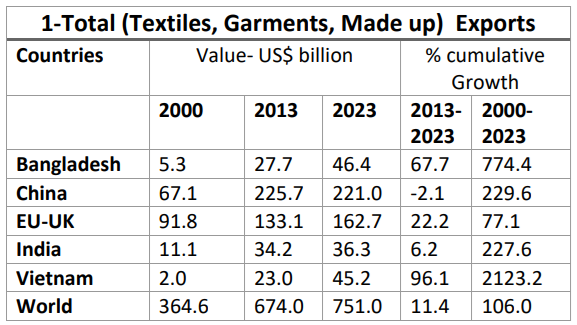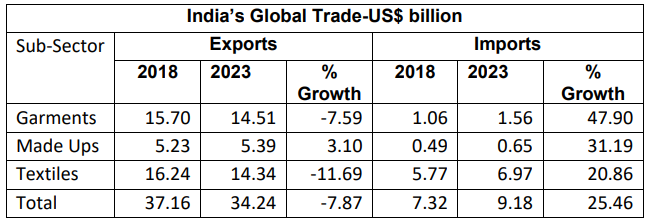
India’s textile industry, once a pillar of its economic and cultural identity, has entered a phase of stagnation that poses a significant threat to its global standing. Historically, this sector has not only been a source of employment for millions but also a reflection of the country’s rich heritage in craftsmanship and design. However, the stark reality of today’s global textile landscape reveals a worrying trend.
In 2023, India’s textile exports amounted to a mere $14.5 billion, a figure that pales in comparison to the exports of China, the European Union, Vietnam, and Bangladesh. This decline is part of a broader pattern of diminishing competitiveness, with the industry witnessing a fall from $37.16 billion in exports in 2018 to $34.24 billion in 2023. The scenario is accentuated by a 25.46% increase in textile and garment imports during the same period, indicating a domestic market increasingly reliant on foreign production to meet its needs.
READ I Lessons from Amul’s success for India’s cooperative sector
The textile industry downturn
Several critical factors have contributed to the decline of India’s textile industry, each interwoven with the other, creating a complex challenge that demands a multifaceted solution. Firstly, India’s under-representation in the synthetic apparel market has been a significant missed opportunity. With less than 40% of its textile exports being synthetic, India has failed to capture a substantial segment of the global market that favours these materials. This oversight has not only limited export potential but also restricted the industry’s ability to integrate into fast-moving global value chains.


The small, informal weaving and processing units, which formed the industry’s backbone, suffers from a lack of technological advancement and economies of scale. This situation results in higher production costs and inferior quality products compared with international counterparts, particularly those from China. Additionally, the compliance rate with fast fashion industry standards in India is alarmingly low, with only 1,200 factories meeting the requirements. This compliance gap significantly restricts access to major international retailers, further diminishing India’s competitive edge.
Compounding these issues are the regulatory frameworks governing labour and contract enforcement. Rigid labour laws and weak contract enforcement mechanisms have stifled the industry’s growth, preventing it from adapting to the dynamic demands of the global market. These regulatory obstacles have made it challenging for India to compete effectively on the international stage, leading to a decline in its market share and global presence.
Charting a course for revival
To wriggle out of this situation, India must adopt a holistic and strategic approach that addresses each of these challenges head-on, says a report by Global Trade Research Initiative. The report puts forward several suggestions for scripting a revival of India’s textile industry. Enhancing synthetic apparel production is of paramount importance. By expanding its footprint in the synthetic segment, India can not only cater to a broader market demand but also ensure that its textile units operate year-round, thereby increasing employment opportunities and wages. This shift requires a concerted effort to modernise production facilities, adopt new technologies, and foster innovation in textile manufacturing.
Strengthening the weaving and processing sectors is another critical step. By upgrading these segments of the value chain, India can reduce production costs, improve quality, and meet the stringent environmental standards demanded by global markets. Investment in technology and infrastructure, coupled with training and capacity-building initiatives, will be key to transforming these sectors into competitive entities on the global stage.
Achieving compliance with fast fashion industry standards is essential for tapping into the lucrative markets represented by major international retailers. Expanding the number of FFI-compliant factories will enable India to respond more agilely to fashion trends, ensuring timely delivery of high-quality products that meet global standards.
Addressing non-tariff barriers through strategic negotiations and diplomatic engagements will further enhance India’s textile export potential. By engaging proactively with trade partners, India can work towards easing restrictions and opening new avenues for its textile products.
Liberalising labour laws will provide the much-needed flexibility for the industry to grow and adapt. By allowing textile units to manage their workforce more efficiently, India can attract investment into large-scale manufacturing operations, which are essential for achieving high volumes and consistent quality.
Finally, improving contract enforcement mechanisms is crucial for building trust with international buyers and facilitating smoother transactions. A more efficient contract enforcement framework will not only enhance India’s reputation as a reliable trading partner but also encourage investment and growth in the textile sector.
The journey towards reclaiming India’s textile glory is undoubtedly challenging, but it is also filled with opportunities. By marrying the rich traditions of its textile heritage with the innovations of the modern era, India can forge a new identity for its textile industry — one that is competitive, sustainable, and inclusive. This vision for the future requires a collaborative effort that spans government, industry, and the artisan community.
Together, they can weave a new narrative for Indian textiles, ensuring that this ancient industry not only survives but thrives in the global marketplace. The path to revitalisation is paved with innovation, adaptation, and a deep respect for the traditions that have long defined Indian textiles. By embracing this path, India can not only regain its lost ground but also set new benchmarks for excellence in the global textile industry.

